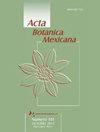Nutritional and nutraceutical components of four Cantharellus species (Cantharellaceae, Cantharellales) from the Mountain Region, Veracruz, Mexico
IF 0.8
4区 生物学
Q4 PLANT SCIENCES
引用次数: 0
Abstract
Background and Aims: Cantharellus species are traded in agricultural markets of the Mountain Region, Veracruz, Mexico, as an appreciated mushroom. The objective of this study was to analyze nutrients and nutraceutical properties in four Cantharellus species from Veracruz: antioxidant activity, total phenols, flavonoids, ascorbic acid, lycopene, and β-carotene; as well as the nutritional properties: dry matter, total ashes, crude protein, crude fat, crude fiber, moisture, carbohydrates and energy value of four wild edible mushrooms (Cantharellus violaceovinosus, C. veraecrucis, C. roseocanus y Cantharellus sp.). Methods: Basidiomas of Cantharellus spp. were collected in the Mountain Region, Veracruz, Mexico. The ITS and tef-1α regions were amplified and sequenced. Species were identified molecularly based on the BLAST results. Samples were lyophilized and stored at 4 °C in vacuum bags for the preservation of nutraceutical and nutritional compounds. A methanol-water mixture (80:20 v/v) was used to extract the nutraceutical compounds and to analyze them by spectrophotometric techniques. Key results: In general, outstanding values were found in C. violaceovinosus both in crude protein content (8.04 g/100 g-1) and in antioxidant capacity 2.28 mg TE/g extract. For flavonoids, C. roseocanus showed 2.98 mg QE/g extract and 6.23±0.68 mg/g of carotene. In addition, a high energy value was found in C. violaceovinosus (266.53 Kcal/100g) and C. roseocanus (222.73±15.43 Kcal/100 g). The nutritional and nutraceutical content of C. violaceovinosus, C. veraecrucis and C. roseocanus is presented for the first time. Conclusions: The results show these species from nutritional and nutraceutical perspectives. Cantharellus violaceovinosus showed the highest values of the parameters evaluated. The consumption of these species constitutes an alternative source of protein and nutraceutical components that contribute to food security.墨西哥韦拉克鲁斯山区四种Cantharellus (Cantharellaceae, Cantharellales)的营养和营养成分
背景和目的:cantharelllus品种在墨西哥韦拉克鲁斯山区的农业市场上作为一种受欢迎的蘑菇进行交易。研究了韦拉克鲁斯州四种油嘴菜的营养成分和营养保健性质:抗氧化活性、总酚、类黄酮、抗坏血酸、番茄红素和β-胡萝卜素;以及4种野生食用菌(Cantharellus violaceovinosus、C. veraecrucis、C. roseocanus y Cantharellus sp.)的干物质、总灰分、粗蛋白质、粗脂肪、粗纤维、水分、碳水化合物和能值的营养特性。方法:在墨西哥韦拉克鲁斯山区采集了Cantharellus属担子瘤。扩增ITS和tef-1α区并测序。根据BLAST结果对物种进行了分子鉴定。样品被冻干,并在4°C的真空袋中保存,以保存营养和营养化合物。用甲醇-水混合物(80:20 v/v)提取营养成分,用分光光度法分析。主要结果:总体而言,紫紫藤粗蛋白质含量(8.04 g/100 g-1)和抗氧化能力(2.28 mg TE/g提取物)均有突出的价值。黄酮含量为2.98 mg QE/g,胡萝卜素含量为6.23±0.68 mg/g。此外,紫果桃红和玫瑰桃红的能值较高,分别为266.53 Kcal/100g和222.73±15.43 Kcal/100g,首次揭示了紫果桃红、紫果桃红和玫瑰桃红的营养和营养保健品含量。结论:从营养和营养保健的角度对这些物种进行了研究。各参数评价值最高的是紫斑蝥(cantharelllus violaceovinosus)。食用这些物种是蛋白质和营养成分的另一种来源,有助于粮食安全。
本文章由计算机程序翻译,如有差异,请以英文原文为准。
求助全文
约1分钟内获得全文
求助全文
来源期刊

Acta Botanica Mexicana
生物-植物科学
CiteScore
1.60
自引率
12.50%
发文量
52
审稿时长
>12 weeks
期刊介绍:
Acta Botanica Mexicana da a conocer trabajos originales e inéditos en todas las áreas de la botánica, incluyendo florística, taxonomía, taxones nuevos para la ciencia, ecología, etnobotánica, paleontología, evolución, conservación, etc. Está dirigida a botánicos mexicanos y extranjeros que aporten información en estas áreas del conocimiento, particularmente con plantas nativas del continente americano. Hasta 2018 apareció cuatro veces al año con una periodicidad estricta en la primera semana de enero, abril, julio y octubre; a partir de 2019 se publica de manera continua, sin periodicidad preestablecida, en formato electrónico y de forma gratuita.
 求助内容:
求助内容: 应助结果提醒方式:
应助结果提醒方式:


